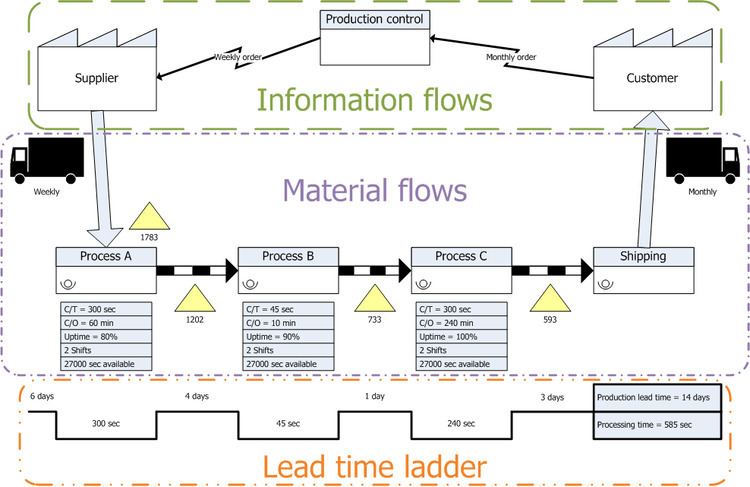 | ||
Value stream mapping is a lean-management method for analyzing the current state and designing a future state for the series of events that take a product or service from its beginning through to the customer. At Toyota, it is known as "material and information flow mapping". It can be applied to nearly any value chain.
Contents
Applications
Value stream mapping has supporting methods that are often used in Lean environments to analyze and design flows at the system level (across multiple processes).
Although value stream mapping is often associated with manufacturing, it is also used in logistics, supply chain, service related industries, healthcare, software development, product development, and administrative and office processes.
In a build-to-the-standard form, Shigeo Shingo suggests that the value-adding steps be drawn across the centre of the map and the non-value-adding steps be represented in vertical lines at right angles to the value stream. Thus, the activities become easily separated into the value stream, which is the focus of one type of attention, and the 'waste' steps, another type. He calls the value stream the process and the non-value streams the operations. The thinking here is that the non-value-adding steps are often preparatory or tidying up to the value-adding step and are closely associated with the person or machine/workstation that executes that value-adding step. Therefore, each vertical line is the 'story' of a person or workstation whilst the horizontal line represents the 'story' of the product being created.
Value stream mapping is a recognised method used as part of Six Sigma methodologies.
In software engineering
The success of Lean in manufacturing and production has led to an interest in its adoption in software development. However, it was noted that the current literature on adoption of Lean in software development had a disconnect between the high-level principles and the concrete practices related to lean and agile software development. The literature had also a limited focus on wastes that were literally mapped from the categories identified for manufacturing. This was ignoring the transformation that lean thinking has itself undergone and moved away from the focus on "removal of waste" to "creating and delivering value". The use of value stream mapping as suggested by the pioneer authors of the field Womack and Jones was identified as the missing link in the current literature on lean in software development.
Value stream mapping analyzes both material (artifact) and information flow. The following two resources exemplify the use of VSM to do it in the context of software process improvement in industrial settings:
Metrics
Two key metrics associated with value stream mapping are value adding times and non value adding times. Non value adding time is called waste or muda.
Associated analysis methods
Hines and Rich (1997) defined seven value stream mapping tools they are:
- Process Activity Mapping
- Supply chain responsiveness matrix
- Product Variety Funnel
- Quality filter mapping
- Forrester effect mapping
- Decision point analysis
- Overall Structure Maps
